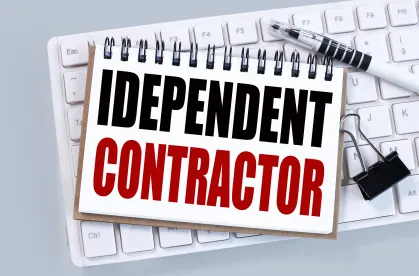On October 11, the Department of Labor (DOL) announced a proposed rule that would replace the Trump administration’s worker classification test, and may make it more difficult to classify workers as independent contractors.
As we previously reported, in January 2021, the Trump administration issued a final rule regarding the classification of independent contractors under the Fair Labor Standards Act (FLSA). The rule, entitled “Independent Contractor Status Under the Fair Labor Standards Act,” endorsed an “economic realities” test to determine the nature of a worker’s relationship with a business and set forth five factors to be considered to determine whether a worker is an independent contractor or an employee:
-
The nature and degree of control the worker has over the work they are performing;
-
The worker’s opportunity for profit or loss in connection with the work;
-
The amount of skill required to perform the work;
-
The degree of permanence of the working relationship between the worker and the employer; and
-
Whether the work is part of an integrated unit of production.
The Trump administration’s rule further identified two of the five factors—the nature and degree of control over the work and the worker’s opportunity for profit or loss—as the “core factors” that carry the most weight in an analysis. The rule provided that, the effect of the other three “non-core” factors was “highly unlikely” to outweigh the combined probative value of the two core factors. Finally, the rule narrowed the facts to be considered under the non-core factors. All totaled, insofar as the rule’s criteria made classification as an independent contractor easier to achieve, it was considered an employer-friendly rule.
By contrast, the new proposed rule (announced on October 11 and issued on October 13) eliminates the use of “core factors” and instead proposes a return to what the DOL describes as 40-years of precedence supporting a totality-of-the circumstances analysis under the economic reality test.
In connection with this “new” analysis, none of the considered factors has any predetermined weight. Rather, each factor should be considered in light of the economic reality of the whole relationship. The DOL further proposes the addition of a sixth “standalone” factor regarding whether the worker’s investment is capital or entrepreneurial in nature, and considering the worker’s investment relative to the employer’s investment.
In terms of what this means for employers, the DOL asserts that the proposed rule is fully aligned with well-settled federal case law in existence before the Trump administration’s rule, and should not trigger an avalanche of misclassification enforcement actions. (Further, the Notice of Proposed Rulemaking identifies several more extreme alternatives that the DOL considered and rejected, including the adoption of a more stringent “ABC test” pursuant to which all workers are presumed to be employees unless the business demonstrates each of three specific conditions.)
The DOL also has noted that there are some limited areas of agreement between the Trump administration’s rule and the new proposed rule. For example, the DOL has left undisturbed the criteria that an employee is someone who, as a matter of economic reality, is economically dependent on an employer for work—not for income. That said, even a subtle shift in the analysis can certainly have a meaningful impact on the nature and frequency of the DOL’s enforcement activities and perhaps lead to more determinations that a worker is not an independent contractor.
The proposed rule still has a way to go before becoming final, so this issue will continue to evolve for some months to come. Comments on the proposed rule are due no later than 45 days from October 13 (i.e. November 28, 2022) and any final rule will not go into effect until mid-2023 at the earliest. Therefore, employers should keep current on the status of this rule and are reach out to counsel to discuss any classification issues that may arise in the near term.




 />i
/>i


